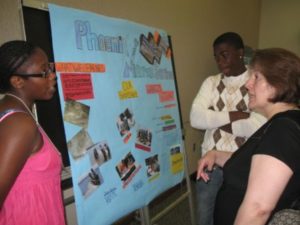Main Content
This month we are going to talk about the importance of leading quality STEM discussions in your animal science club. I recently read a great book by Karen Gallas called Talking their Way into Science. In the book Karen talks about how hands-on activities are not enough to help young people construct meaning and make sense of the topic. In order to avoid misconceptions and connect the learning, we have to provide time and space for meaningful discussion and reflection. This does not mean your role as the club leader is the “KIA person” or Know it All as my dad used to say. Instead, it means you are the “Guide on the Side” and mentor who helps young people create their own understanding through discussion and interactions with materials and various sources.

As a club leader, learning how to facilitate good discussions can open doors at every stage of the learning experience in your club. For example, good use of questions can create interest in a new topic, help guide their active explorations, stimulate sense-making of new concepts, and encourage young people to apply their ideas to different situations. Most importantly, well-sequenced questions can initiate the sharing of ideas, encourage development of multiple hypotheses or alternative explanations, help young people recall prior knowledge, allow them to synthesize new information, and help guide logical thinking.
You are probably thinking, that all sounds great, but it is easier said than done. I have some ideas for you! I have been fortunate to work with the Lawrence Hall of Science at the University of California, Berkeley for many years on a broad range of projects. I learned from them how to balance broad and focused questions to help engage young people in quality discussions. I am going to share the highlights here:
Broad questions are those that anticipate a variety of acceptable and generally unpredictable responses. Broad questions:
- encourage interacting with peers
- evoke more than one acceptable response
- encourage divergent thinking or different points of view
Focused questions on the other hand are those that anticipate a particular, predictable response planned by the club leader. Focused questions:
- require recall of specific information
- focus responses on the topic
- keep the interchange short and to the point
- encourage single, correct responses
At your next club meeting try a Discussion Map.
Discussion Map
#1- Ask a broad question
#2 -Ask about the evidence for their explanation
#3- Ask for alternative opinions or ideas
#4 -Lead club members back to the main topic
At each step, listen carefully to each response and try to figure out their thinking.
It is important to note that that neither type of question should be considered good or bad, but that the two different types tend to generate different types of responses. For this reason, as a club leader you need to try to be aware of the particular circumstances in which it’s best to use different types of questions. Next month we dive into the scientific method!
By Janice McDonnell, Science Agent, Rutgers Cooperative Extension